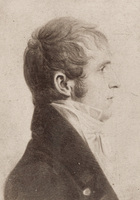 | Back to e-WV
| Back to e-WV
 The West Virginia Encyclopedia
The West Virginia Encyclopedia
 | Back to e-WV
| Back to e-WV
 The West Virginia Encyclopedia
The West Virginia Encyclopedia

Virginia Governor William H. Cabell (December 16, 1772-January 12, 1853) was a major Cabell County landowner and the man for whom the county was named. He was born in Cumberland County, Virginia, the son of Nicholas Cabell and grandson of Dr. William Cabell, a surgeon in the British Navy who settled in Virginia in 1724. Cabell attended Hampden-Sydney College (1785–89) and then entered the College of William and Mary, receiving a law degree in 1793. He served in the General Assembly from Amherst County from 1796 to 1799 and from 1802 to 1805, when he was elected governor of Virginia by the state legislature. He was elected to two more annual terms, serving until 1808.
Cabell was governor at the time of the Aaron Burr conspiracy, critical events of which took place at Blennerhassett Island near Parkersburg, and during Burr’s arrest and trial for treason. Upon completion of his service as governor, Cabell became a Virginia State Supreme Court justice and later died at his residence in Richmond. He is buried at Shockoe Hill Cemetery in Richmond.
Kanawha County was divided in January 1809, soon after Cabell’s service as governor, and Cabell County was formed. William Cabell later came to own more than 4,400 acres of land in the county, at Greenbottom, on the Ohio River north of present Huntington, including eight miles of riverfront. He bought the land about 1819 at a trustee’s sale in Richmond, apparently sight unseen, and he never lived in Cabell County.
Written by Emmitt Maxwell Furner II
Wallace, George Selden. Cabell County Annals and Families. Richmond: Garrett & Massie, 1935.